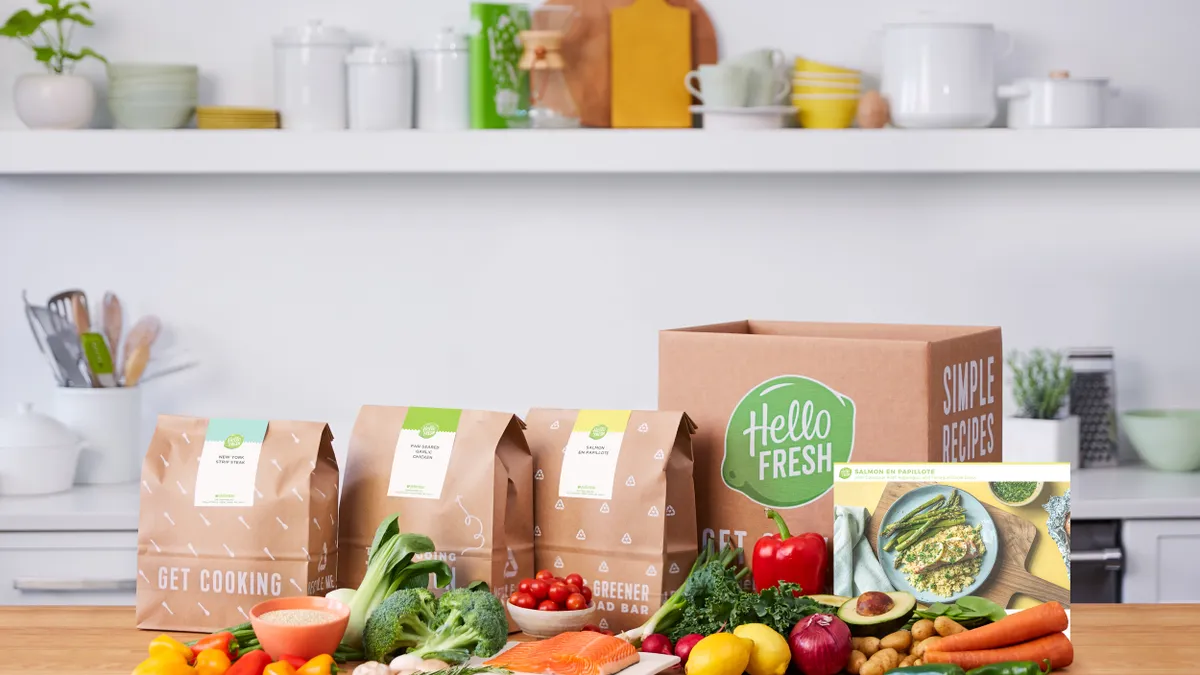Dive Brief:
- HelloFresh North American president Tobias Hartmann told Food Dive in an interview Friday that the company will likely overtake Blue Apron as the U.S. meal kit market leader by this year’s second quarter. The German company, which went public in Europe last year, is the global market leader, with operations in 10 countries and a valuation of $1.6 billion.
- Hartmann acknowledged concerns over the viability of the meal kit business model, but said much of this is due to the visibility of a company which has struggled with its operations. Without actually naming that company, Hartmann said, "There is one company in particular that is not profitable ... It's not fair to say they are representative of the industry."
- HelloFresh has stated it will turn profitable by this year's fourth quarter. "We are absolutely certain of this," Hartmann said.
Dive Insight:
The struggles of U.S. market leader Blue Apron have underscored the perils of the meal kit industry, but that company alone doesn't account for investors' increasing skepticism. Research shows that meal kit companies across the board spend a lot of money to acquire customers, and often struggle to hold on to them for more than a few months. Grocery companies — including Amazon — are also moving in on the market and introducing new culinary models, raising the question of whether online kit companies can truly own consumer demand for assisted meal prep at home.
Tobias Hartmann says he can't speak for other companies in the space, but maintains that HelloFresh is tapping into a strong and growing market.
"There have been a lot of journalists questioning whether this is a viable business model," he told Food Dive. "But let me tell you this: There are millions and millions of customers across the globe who love the concept. So from a consumer perspective, is this a viable business model? 100%."
HelloFresh debuted on the German stock market last November, and unlike Blue Apron it hit its valuation range of between €9 and €11.50. It is also more operationally disciplined than its U.S. rival, with higher operating margins, stable customer acquisition costs and no high-level fiascoes. Over the past year, HelloFresh has grown its global consumer base by 52% to 1.28 million, and has grown its revenue 48%.
Many of its competitors, including health-focused Sun Basket, focus exclusively on market segments like regional cuisine, vegetarian cooking and special diets. HelloFresh is hitting on these segments too, trying to outmuscle smaller competitors with its marketing spend, data gathering and other assets. Hartmann pointed to HelloFresh's "one pot" cooking line, its global cuisine line and its recently introduced 20-minute prep offerings as examples of "niches" the company is pursuing, and will continue to pursue this year.
Hartmann said HelloFresh, like other kit companies, would like to expand into other meal times, though he noted the company has no offerings geared towards lunch or breakfast yet.
"We've solved that most complex meal occasion, which is dinner," he said. "Now the question is, how do you expand into other occasions?"
As for grocers like Kroger and Publix that have developed meal kit lines, Hartmann said this validates the meal kit concept — though he dismissed the threat these companies pose, saying, "They are retailers. They're not in the business of creating food." Still, HelloFresh has partnered with grocers in other countries and could do the same here in the U.S. Major supermarkets have been in contact with meal kit companies, and analysts speculate more deals like Albertsons' acquisition of Plated could be on the horizon.
Hartman said HelloFresh's increasing scale will help the company cope with high marketing costs. According to him, the company earns $3 for every dollar it spends. But the question of whether it — along with other meal kit companies — can acquire customers without spending large and growing sums of money lingers.
Daniel McCarthy, an assistant marketing professor at Emory University who follows the meal kit industry, recently crunched some of HelloFresh's numbers and found that the company actually has a lower six-month consumer retention rate (17%) than Blue Apron (28%), and spends more of its overall budget on marketing (30%) than its close rival (25%).
"These figures would suggest that HelloFresh is on the same 'acquisitions treadmill' that Blue Apron is on, just set to a much faster speed," McCarthy wrote in a LinkedIn post. "So while I agree with HelloFresh's CEO that the company has faster growth and better market share gains, this is entirely due to the fact that HelloFresh is spending large and rising sums of money on customer acquisition expenses."









